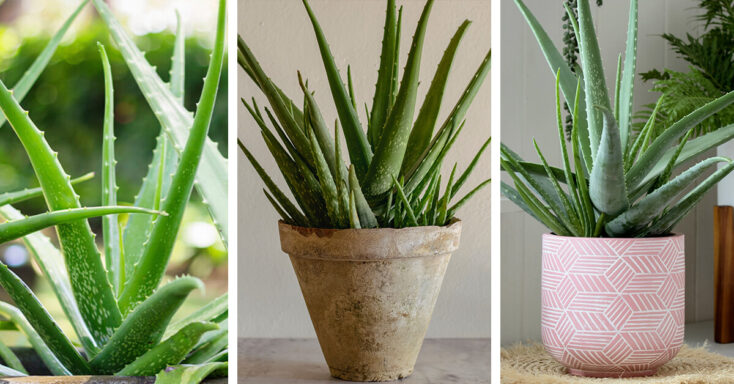Aloe Vera is a member of the succulent family, which has fleshy regions for restoring water. You can grow Aloe outdoors, but you’re more likely to find one on a person’s desk or in their home garden because it’s a plant that’s easily cared for.
Aloe has a pretty presentation with green leaves (or green with white spots) growing in a rosette. The spines seem pink, and what you may not know is that Aloe Vera plants produce flowers!
Key Takeaways
- Growing and caring for an indoor aloe vera plant is exceptionally simple, making it a good choice as a starter plant.
- Aloe Vera has a variety of wellness applications because it is a powerhouse of antioxidants, vitamins, enzymes, and minerals.
- While Aloe Vera plants flower, they don’t do so often indoors. So don’t worry if you see no such development. There’s nothing wrong with your plant.
- Aloes reach their maturity in 3-4 years.
Assessing Aloe
Over the centuries, Aloe received renown as part of the healer’s kit, as well as its use in beauty preparation. The name derives from the Arabic, Alloeh, which translates as “shining bitter substance.” Vera, however, comes from Latin, meaning “true.”
The ancients held Aloe Vera in high regard. The Greeks considered it a type of universal panacea, while the Egyptians called Aloe the “plant of immortality.” High Praise, but continued use of Aloe, especially in dermatology, shows these early cultures knew what they were talking about.
Each Aloe Vera leaf has three layers. The first is the clear gel, the second is a bitter yellow sap, and the third is a thick layer of cells you can consider a “rind.” The third layer protects the plant while synthesizing proteins and carbohydrates.
Aloe vera speeds wound healing because it improves blood circulation in the area. Products containing aloe vera increase white blood cell count, providing greater support to the immune system.
Your Guide to Aloe Vera Plant Care
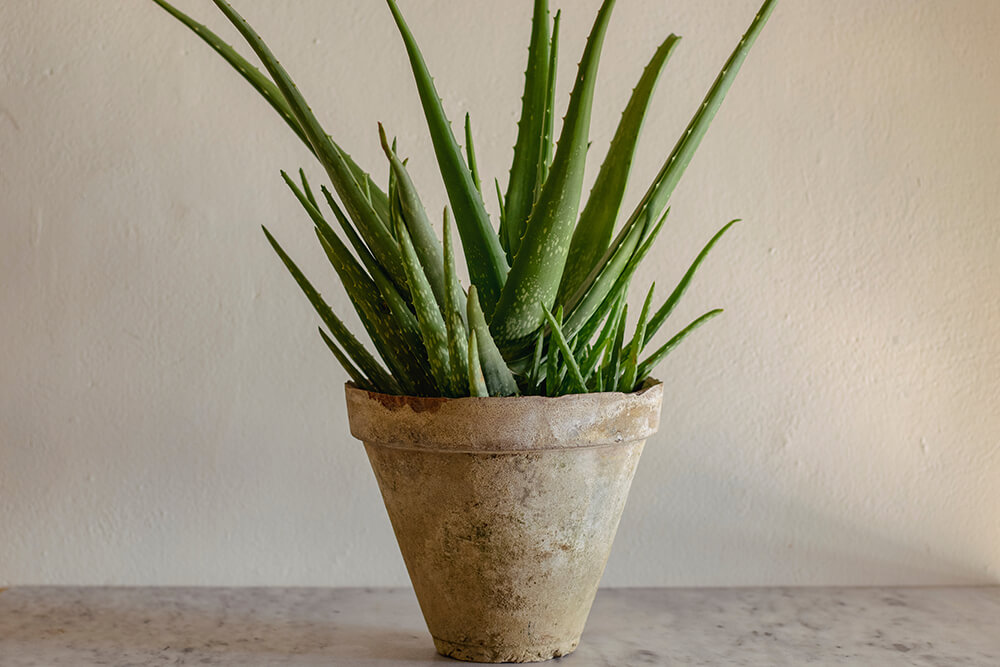
Caring for aloe vera plants isn’t difficult. All you need is lots of light, a little water, and nearly NO fertilizer! When you take care of it properly, your indoor aloe can live up to 12 years! Let’s look a little closer.
- Fertilizer: You can use standard houseplant fertilizer or those made specifically for succulents on your aloe. Take care, however, as too much will harm your plant. Take care to dilute the fertilizer to half-strength.
- Light: Bright, indirect sunlight is required to keep aloe plants healthy. Any window that doesn’t receive full sunlight will do the trick. If you have a dark home with little natural light, try using grow lamps.
- Soil: Avoid gardening soil. Use a commercial mix, or blend sand, peat moss, and perlite together yourself. Make sure the pot has proper drainage holes. If not, the best soil in the world won’t protect your aloe from rot.
- Temperature: Keep it on the warm side. 70F is an ideal median. Make sure you put your aloe well out of the way of drafts. When they get too cold, they pucker and yellow.
- Water: Unless you live in a dry, hot environment, aloe only needs water once a week. Always check to see if the soil is dry first. If so, give it a good soaking, let it drip out, and return it to a sunny location.
When you look at an aloe plant, it may not appear appetizing. Nonetheless, commercial foods often use aloe in things like yogurt. At home, properly prepare the aloe vera. Open each leaf lengthwise, and carve out the inner gel. Remove the yellow coating. Give the remainder a rinse, and you can then add it to things like smoothies or even popsicles.
Indoor Aloe Vera Needs
Aloe flourishes indoors, so you won’t find it overly needy. One thing that can support healthy plant growth is using a terracotta pot. Look for one with 2” to spare on all sides of your aloe. Terracotta provides water wicking, keeping excess moisture at bay. During warmer months, give it a little more water, and in cooler ones, decrease your watering schedule. Always remember to let the soil dry out between watering.
If you notice your plant looking a little under the weather, check the lighting. It may be in an area that’s too dark. Adjust accordingly.
Queen Approved: Queen Cleopatra applied aloe gel to her body to retain her beauty. Interestingly enough, studies reveal aloe can penetrate the epidermis of the skin. In turn, products containing aloe improve the absorption of healthy vitamins
Aloe Vera Plants for Your Home
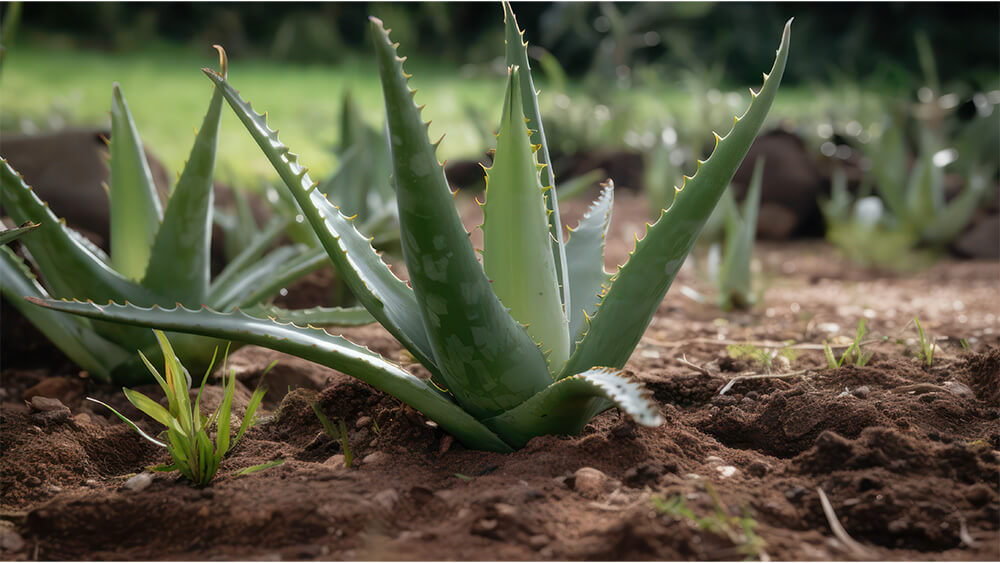
The aloe genus has over 500 varieties, not to mention hybrids and cultivars. Here are a few you might like for your home.
Carmine: A lovely little gray-green aloe with pale green bumps. Carmine’s teeth are orange-red. Mature height – 10 inches.
French: A taller aloe suited to entryways or other high spades (6’ tall). Its rosettes are chartreuse dotted with pale green teeth. It will grow in a shady location.
Gold Tooth: A clumping aloe that, as you might expect, has gold spikes. This aloe has short green leaves and may grow to be 18 inches tall.
Guido: A small hybrid with striking light green, dark green adorned leaves. It almost looks like a checkerboard. It grows to about 7 inches tall. If you’re lucky enough to get flowers, they’re white or yellow (sometimes red).
Spider: Also known as blue dwarf aloe, this diminutive aloe reaches 1 foot tall at maturity. It’s only 5 inches wide with pale blue leaves.
Spiral: A visually striking aloe with silver-gray-green leaves growing in a spiral, either clockwise or counterclockwise. It’s a slow-growing plant, needing repotting every three years. Size 1 foot tall, 2 feet wide.
Sunset: While Sunset begins bright green, it will turn flashing red in good lighting, flecked by white spines. It will grow to about 1 foot tall and 2 feet wide and brighten any part of your indoor landscape.
Partridge Breast: Also known as tiger aloe, this plant has elongated leaves with wavy white lines running horizontally. It usually stays below 1 foot tall.
Tiger Tooth: Prefers warm, dry climates but very adaptable. Mature height 12”, width 24”. Per the name, the white spines growing off the leaves look sharp, like a tiger’s tooth.
The aloe plant appears on 4,000-year-old Sumerian tablets with notes as to their digestive benefits. The first published reference came by way of John Goodyew in 1655, translated from Dioscorides’ De Materia Medica.
Watering Indoor Aloe Vera Plants
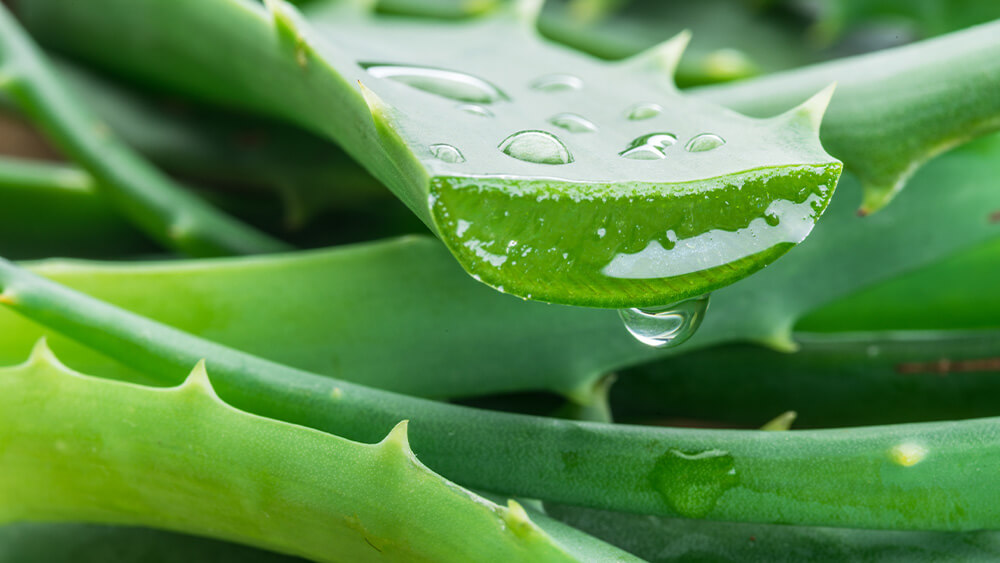
As succulents, aloe vera plants don’t really need a ton of water. In fact, they’ll rot if overwatered. In general, once a week is fine for aloe plants unless the weather becomes very dry and hot. Place your finger into the plant’s soil. If it is dry down to one inch, that’s a go-ahead to water.
Direct liquid to the base of the plant so it reaches the roots. Go slowly. When the water begins emerging through the drain holes in the pot, stop. This provides moist soil without it becoming soaking wet.
Sure to Soothe: The best-known quality of aloe is the ability to soothe. It has cooling properties akin to menthol. Apply a dab to bug bites, sunburn, scratches, and minor kitchen burns. Never apply to an open wound.
Potting and Repotting an Indoor Aloe Plant
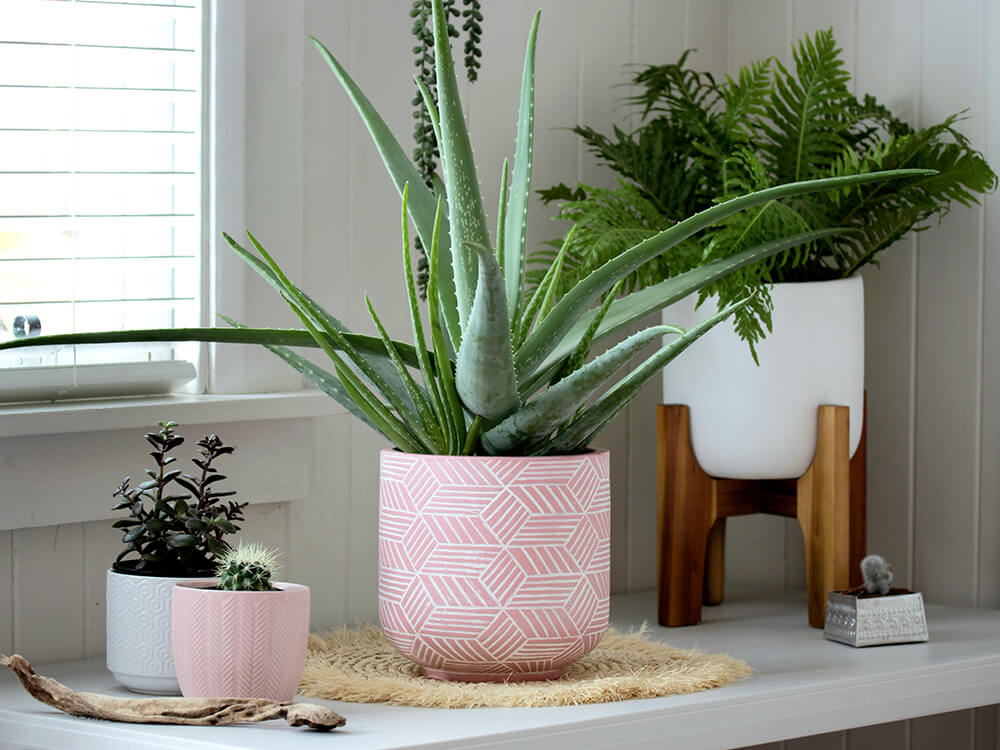
The process for potting and repotting is pretty much the same. When you bring your plant home from the nursery, you’re transplanting it into a new container (thus repotting). You require a crock about 2 inches larger than the aloe.
So long as your plant does not show signs of overwatering, give it moisture a day before you repot. Gently release the plant from its current container. Remove soil debris adjacent to the roots. Fill the new container ⅓ of the way with a well-draining soil mix (there are some blends specifically for aloe). Center the plant in the new soil. Now fill in around the stem with more mix. Water the aloe and give it indirect sunlight right away.
Aloe Plant Propagation
As your aloe matures, it will produce offsets called pups. These look like tiny replicas of the mother plant. When one appears, remove it from the parent with some root. Let it sit for two days.
Place your baby aloe into its new home with a cactus mix and care for it as any other.
Looking at an aloe vera plant, the spikes might make you think immediately of a cactus. But aloe is not a cactus at all. In fact, its genus is just “aloe.” Of all the aloe plants, aloe vera is best known because it’s the standard for healing purposes.
Aloe Vera Pruning and Maintenance
While aloes look pretty self-sustaining, a little pruning keeps your plant growing properly. When you see the tips brittle and brown, simply pluck them off. If you notice old growth below, clear that out, too.
Whatever you do, avoid cutting the center leaves. They are the newest growth and healthiest part of your aloe. You want at least 6 leaves on your plant for proper photosynthesis.
Healthy Hair: Aloe Vera gel hydrates hair. It soothes the scalp, strengthens hair strands, and conditions naturally. Mix one tsp honey with 2 tsp aloe gel and 2 tsp coconut oil. Massage this into your scalp. Leave for 30 minutes, and then wash out.
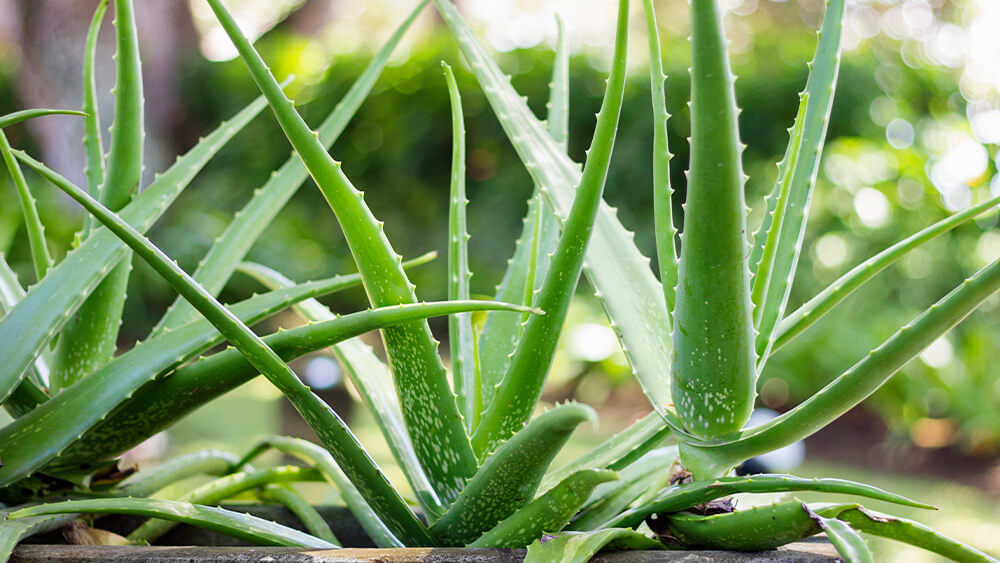
Aloe Vera Blooming and Resting Periods
It takes four years before an aloe is mature enough to blossom. Even then, it happens rarely indoors. Most species flower between spring and fall. A trick to try and persuade blossoming is letting it go completely dry. It will require 12-5 hours of daylight and only the slightest amount of water. This is a resting period. Keep temperatures around 55F.
After 8 weeks, bring it out into a warmer space (75F). Start watering as usual and apply fertilizer. Your aloe will live, but if you’re very lucky, it will send up a flower stalk. If not, don’t beat yourself up. This is common with indoor aloe vera plants.
Factoid: An aloe plant can live upward of 100 years.
Indoor Aloe Vera Pests & Diseases
Being inside doesn’t protect your plant from pests or diseases all the time. Bugs can come into the house on people, pests, bags, etc. Some disease can come home with you from the nursery or result from unhealthy conditions.
Aloe is at the top of a spider mite’s menu. You may notice tiny pale markings on the aloe. Additionally, the damage may distort leaves. A little insecticide power in your plant’s center should do the trick. Gall mites take to the base of older leaves. Here they set in and form galls. Trim off affected parts and treat the whole plant with a systemic insecticide. TIP: if you have more than one aloe in the house, keep them apart from each other during treatment.
If you find a snout beetle on your plant, be ready to spring into action. These are fairly visible, measuring up to ¾” long. It directs its attention to the center of the plant, wedging itself neatly in such a position that its snout drinks the leaf sap. This leaves behind a dark spot with a puncture in the center.
The adult snout beetle is one thing, but their larvae are worse. The eggs go onto a leaf base, and the larvae head directly into your plant’s stem. You will need to remove all parts of the plants showing boreholes. Afterward, try re-rooting it in fresh media. If it lives, apply an insecticide for upkeep.
Stem rot is a familiar disease among aloes. Cold or wet conditions lead to rotting stems. The areas affected look reddish brown or black. This is hard to combat because the rot travels right up the plant’s stem. If you don’t catch it early, it’s time to buy another plant.
One fungal infection among aloes is Aloe Rust. It manifests as blow or black spots on the leaves. It won’t kill your plant. Just cut off leaves as they show issues. Avoiding rust comes down to making sure your plant has good air circulation, aloe leaves aren’t damp, and the temperature stays around 70F. One home remedy is mixing one tsp baking soda in a quart of water and washing off the plant weekly.
Beliefs about the Aloe indicate that the ancients viewed it as incredibly important. The Hindus, for example, claim aloe came from the Garden of Eden. Mesopotamians felt it was a holy plant capable of protecting against evil intent. A king’s status might be measured by how much aloe he gifts during a visit. And aloe was part of the Egyptian embaling process for Pharaohs.
Troubleshooting Common Aloe Vera Problems
There are two very common problems among aloe vera plants. First is excess water. Too much water yellows the aloe’s leaves and makes them mushy. They might even smell rotten. If you were to lift your plant out of the soil, you might discover brackish roots. When this happens, let the plant dry out. Trim off the rotted roots, and prune unhealthy growth. Repot the aloe into fresh, well-draining media.
The second is insufficient lighting. There are a few aloes that can tolerate low light conditions, but the vast majority prefer bright indirect sunlight. Without that, the plant starts looking wrinkly. It also becomes leggy and pale. Give it a dose of fresh light, but don’t keep it in direct light for long. It can burn the leaves.
Aloe & Alexander the Great: Legends say that when Alexander the Great’s armies needed healing, he would sail them to islands rich with aloe vera. Here they would convalesce until returning to battle. Besides applying aloe, the soldiers drank it, believing it made the indestructible.
Frequently Asked Questions About Aloe Vera Plants Care and Keeping
Do aloe plants need direct sunlight?
Direct sunlight, no. Bright indirect light, yes. Your kitchen window is often a perfect place to poise your plant. If your home doesn’t get enough natural light, supplement with grow lights.
Do aloe plants need more water or sun?
White aloe vera needs both, between the sun and water, the sun is more important. Bright, indirect light is aloe’s best friend. Direct sunlight can dry out your plant too much, making the leaves yellow. In this case, your plant will need water, followed by moving it into an area without direct light.
Why is my aloe plant dying?
There are a lot of potential reasons your aloe vera plant isn’t thriving. First, if you notice the leaves drooping, that’s often a lock of sun (they need 6 hours daily). Yellowing leaves imply overwatering. There is also a chance your plant has pests or developed a disease. You’ll need to inspect it further to rule things out.
How do you fix aloe vera that is dying?
If the cause is root rot, scale back your watering schedule. Let your plant dry out, and then transfer it into soil offering good drainage. The leaves and roots that look sickly can be removed. If the weather takes a sudden change for the cooler (below 50F), it can cause stress in your plant (if it’s near a cold window, for example). Move your plant out of the drafts where its warmer.
Should I cut off dying aloe leaves?
Dying leaves do nothing for an aloe plant. Just prune them. So doing this gives the aloe more energy to direct toward new growth.
Summary
Aloe vera not only makes a refreshing addition to your indoor landscape but also one that’s functional. Just break a little off the next time you have a minor kitchen burn, for example. Since Aloe is a succulent, it is drought-tolerant. Care must be taken, however, to avoid overwatering. It can drown the plant, rotting it at the roots. Give your aloe enough sun and air circulation, and it should live a long and happy life.

